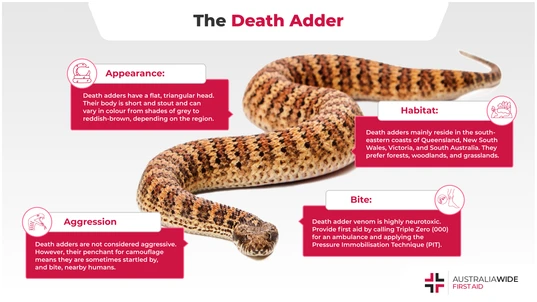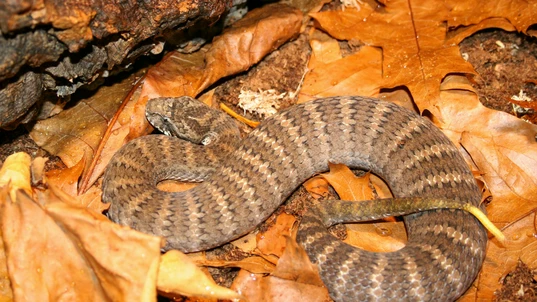Snake Facts: The Death Adder

Bites and Stings

The Death adder is one of the most venomous snakes in Australia and across the globe. Renowned for their excellent camouflage abilities, Death adders can kill humans in a matter of hours without prompt treatment.
Discovered by French naturalist Francois Marie Daudin, the Death adder is one of the most venomous snakes in the world, and is the only species in the Acanthophis genus. Native to Australia, New Guinea and nearby islands, the existence of Death adders is at threat due to ongoing invasion by the Australian cane toad.All About the Death Adder
The Death adder, otherwise known as Common death adder, is native to Australia and mainly resides in the south-eastern coasts of Queensland, New South Wales, Victoria, and South Australia. Several species of Death adders can be found in other parts of Australia, such as the Northern Territory and Western Australia – however, they generally live in areas abundant with forests, woodlands, and grasslands. As one of the most venomous land snakes in Australia and globally, the death rate from a Death adder bite was approximately 50% prior to the development of the Death adder anti-venom in 1958. However, due to human encroachment into Death adder habitat, much research has gone into these wild animals to mitigate human-Death adder conflicts. In addition to this, Death adders are now being threatened by the introduction of Cane toads in Australia, which has resulted in a drop of Death adder populations by almost 89%. Death adders can give birth to up to 24 live young between the summer months of December and March. New-born Death adders are around 12cm in length from the tip of their snout to the base of their tail. Females reach reproductive maturity at roughly 2 – 4 years old. Males, meanwhile, reach reproductive maturity at 2 years old.
Death adders commonly reside in forests, woodlands, and grasslands on the eastern coast of Australia. They have a stocky body and arrow-shaped head, and tend to be grey to reddish-brown in colour.
Identifying a Death Adder
Death adders are quite distinctive in their figure. Unlike most snakes, which are renowned for their long, thin bodies and sharp heads, Death adders are typically short and stout – the only thin parts of their body is their neck and tail, the latter of which has a curved tip. Death adders are also known for their triangular-sized head. Some other common identifiers of the Death adder are listed below:- Colourations vary region to region from shades of grey to reddish-brown
- The back is marked with lighter coloured bands
- The belly can vary from grey to cream depending on the region
- Average length is approximately 0.65m with the maximum length recorded at 1.1m long
- Death adder fangs range from 6 – 8mm in length and resemble those of vipers
Death Adders and Their Hunting Habits
In contrast with other native Australian snakes, which are mostly active foragers, the Death adder waits for its prey by sitting still in one place and camouflaging itself under leaves. Even when approached by predators, this snake will often remain motionless as a defence mechanism. This has subsequently earnt them the alternate name of the ‘Deaf adder’, based on the belief that they cannot hear approaching humans. Death adders often feed on small animals such as frogs, lizards, and birds. Once their prey is within striking distance, these snakes will react with lightning speed and inflict a highly venomous bite. Death adders do sometimes twitch their tail close to their head as a lure for curious animals. The Death adder will then wait for its prey to die from envenomation before eating it.Are Death Adders Dangerous to Humans?
Death adder venom contains a highly dangerous neurotoxin that can cause human death six hours after the initial bite, while smaller mammals such as dogs experience worse reactions and on average live only 20 minutes after the initial bite. The average venom output by a Death adder is around 85mg with a maximum recorded venom output of 235mg. Due to their relatively large fangs and toxic venom, these snakes are efficient killers that are to be feared. Symptoms of a Death adder bite include:- Muscle paralysis,
- Abdominal pain,
- Drowsiness,
- Enlargement of regional lymph nodes, and
- Headaches.
First Aid for a Death Adder Bite
If you are bitten by a Death Adder, it is crucial to act as soon as possible to stop the venom from circulating through the body. Call Triple Zero (000) for an ambulance and perform the following first aid steps:- Keep the casualty at rest and as still as possible to stop the venom from travelling through the body.
- Constantly observe and reassure the casualty.
- Follow DRSABCD and be prepared to perform CPR
- Apply the ‘pressure immobilisation technique’ (PIT):
If the bite site is on a limb, cover it with a wide heavy elastic bandage (10 - 15 cm wide).
Ensure the bandage is firm and tight, so tight you cannot easily slide a finger between the bandage and the skin.
Apply a second heavy elastic bandage. Start from the fingers or toes and wind up the limb as far as possible. Consistent coverage (overlapping half over half) and consistent pressure (firm but not cutting off circulation) are key to an effective PIT. - On the bandage, mark the spot where the bite occurred with a pen or felt-tip marker.
- Immobilise the limb and joints with a splint, or use a sling if the bite site is on an arm. Keep the limb immobilised until the ambulance arrives.
Looking to get you First Aid knowledge up to date?
We run certified First Aid courses throughout all major Acustralian citys. Find a location near you.
Death Adder Bite and Anaphylaxis
Some people can have a severe allergic reaction when bitten by a Death adder. This is called anaphylaxis, a condition that can be fatal in as little as 15 minutes. Symptoms include:- Tightness of the throat from swelling.
- Difficulty breathing.
- Tongue and facial swelling.
- Hoarse voice or difficulty speaking.
- A wheeze or persistent cough.
- Collapse or falling unconscious.
- Becoming pale or floppy (young children).
- Abdominal pain and vomiting.
- Hives, welts, and body redness.
Death Adder Fun Facts
- According to the Queensland Department of Environment and Heritage Protection, Common death adders are categorised as ‘vulnerable’
- Death adders are nocturnal or diurnal depending on the temperature of their environment
- Death adders are one of the easiest snakes for professional snake handlers to handle
- Producing venom takes a lot of energy therefore most death adders do not always inject their bites with venom
Final Thoughts
Death adders are extremely dangerous, and caution should be exercised whenever treading into Death adder habitat. With the invention of antivenom and the development of modern medicine, the mortality rate from Death adder bites is rather low, and most of those that occur in urban areas do not contain any venom. However, as humans continue to encroach on the habitat of wild animals, it is important to develop the knowledge and skills to provide first aid in any medical emergency. To learn more about identifying and treating bites from some of Australia’s most venomous snakes, book a First Aid course with us today.
Originally published at
https://www.australiawidefirstaid.com.au/resources/death-adder
as part of the Australia Wide First Aid Articles Library









